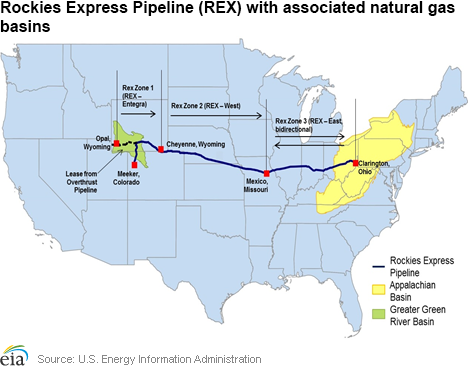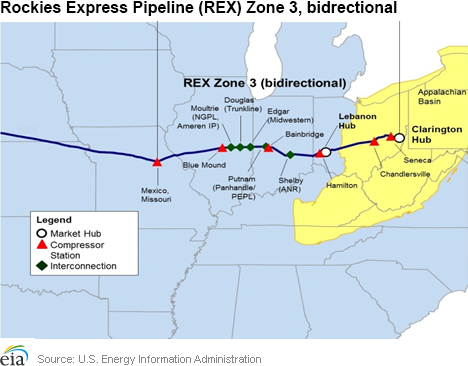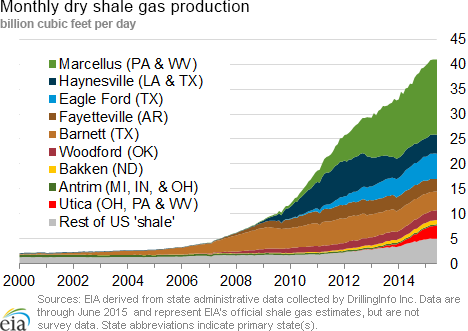In the News:
Rockies Express Pipeline (REX) nears completion of Zone 3 east-to-west reversal
The Rockies Express Pipeline (REX) is completing construction on compressor stations and interconnects for its Zone 3 east-to-west project and expects to bring Zone 3 online on or about August 1. Once the final leg of the project is placed in service, Zone 3 will be fully bidirectional, with the ability to move 1.8 billion cubic feet per day (Bcf/d) of natural gas in either direction from the Clarington Hub in Monroe County of eastern Ohio to the Mexico compressor station in Audrain County, Missouri.
One of the longest pipelines in the United States, measuring more than 1,700 miles in length, REX is divided into three zones. REX began service in November 2009 to move up to 1.9 Bcf/d of natural gas east from the Rockies to meet demand in midwestern and northeastern markets. As Marcellus production increased in the Northeast, the demand for REX-supplied gas decreased. In response to changing market conditions, Tallgrass Development, the operator of REX, began construction that would allow for physical flow reversal as well as traditional backhaul on REX's easternmost zone, Zone 3, to move Appalachian Basin production westward.
REX Zone 3 is an unusual backhaul pipeline in that it can physically flow gas westward as well as arrange backhaul transactions through traditional displacement. Because gas is fungible, it makes no difference to buyers whether the molecules come from the Rockies or the Marcellus.
The project was completed in several stages, with the first westbound natural gas flows beginning in June 2014 from the Seneca Lateral pipeline in southeast Ohio (see map). Initially, the Seneca lateral had the capacity to move 0.25 Bcf/d of Marcellus production into the REX mainline, and that capacity increased to 0.6 Bcf/d in the first quarter 2015. As additional receipt points were made available, the REX reversal allowed gas to move farther west. To date, REX has delivered gas as far west as Edgar County, Illinois to its interconnection point on the Midwestern Gas Transmission Company pipeline. On completion of the east-to-west project, gas will flow farther west to Moultrie County, Illinois, and its interconnection with the Natural Gas Pipeline Company of America (NGPL).
This east-to-west project has secured firm, 20-year contracts for east-to-west flows with American Energy Appalachia, EQT Energy, Gulfport Energy Corp, and Rice Energy, and will access interconnects with ANR, Midwestern, NGPL, Panhandle, and Trunkline pipelines. Completion of the project will allow the movement of up to 1.2 Bcf/d of natural gas, in addition to the 0.6 Bcf/d delivered from the Seneca lateral, for a total westbound firm capacity of 1.8 Bcf/d along the entire length of REX Zone 3, with no effect on eastbound transit. Westbound outflows measured at the Hamilton, Ohio, compressor station in early July, as reported by Bentek Energy, confirmed that approximately 70% of the natural gas flowing west on REX Zone 3 moved out of the Northeast region, demonstrating the demand for a low-priced supply of natural gas from the Marcellus/Utica plays.
Even before bringing the east-to-west expansion online, REX was planning a Zone 3 Capacity Enhancement that will increase east-to-west capacity by an additional 0.8 Bcf/d, bringing the total capacity for westbound service to 2.6 Bcf/d through the incorporation of additional receipt points. Tallgrass Energy and its partners believe that this expansion will improve their ability to serve Midwest markets, including Chicago and Detroit, along with delivery to Gulf Coast and Southeast markets. If approved, REX anticipates a fourth-quarter 2016 in-service date for this capacity enhancement.
Overview:
(For the Week Ending Wednesday, July 22, 2015)
- Natural gas prices were flat or slightly down at most market locations through the report week (Wednesday, July 15, through Wednesday, July 22). The Henry Hub spot price began the week at $2.92 per million British thermal unit (MMBtu) last Wednesday and ended the report week down a few cents, closing at $2.89 yesterday.
- At the New York Mercantile Exchange (Nymex), the August contract began the week at $2.918/MMBtu last Wednesday and decreased by 2¢ to settle at $2.897 yesterday.
- Working natural gas in storage increased to 2,828 Bcf as of Friday, July 17. A net injection into storage of 61 Bcf for the week resulted in storage levels 28% above a year ago and 3% above the five-year average for this week.
- The total oil and natural gas rig count decreased by 6 units to 857 for the week ending Friday, July 17, according to data from Baker Hughes Incorporated. The oil rig count decreased by 7 units, totaling 638, while the natural gas rig count increased by 1 to 218. Horizontal rigs accounted for 76% of all rigs this week, down from an all-time high of 78% in April, but up from 2014, which averaged 68% horizontal rigs for the year.
- The natural gas plant liquids composite price at Mont Belvieu, Texas, increased by 17¢ to $4.68/MMBtu for the week ending July 17. The price for natural gasoline was nearly flat, falling by 2¢, but prices for ethane, propane, butane, and isobutane all increased between 3% and 8% for the week.
Prices/Demand/Supply:
Natural gas prices were flat or down slightly at most locations. The weather grew increasingly hot through this past Monday in most of the country and production trended down a bit, though prices seemed relatively unresponsive outside of the Northeast. The Henry Hub price fell through Monday and ended the week down 3¢, moving from $2.92/MMBtu last Wednesday to $2.89 yesterday. Prices at most locations mirrored this pattern. Cheyenne Hub in Colorado began the week at $2.82/MMBtu, dipped to $2.70 on Friday, then rebounded to $2.81 yesterday. PG&E Citygate serving Northern California moved from $3.25/MMBtu last Wednesday to $3.16 on Monday, and closed up slightly at $3.27 yesterday.
Northeast prices rise early this week on hot weather but end down. Prices in the Northeast rose throughout the report week as temperatures moved above seasonal norms. Temperatures peaked on Monday, when parts of the region averaged over 80° Fahrenheit for the day. At Algonquin Citygate, serving Boston, prices started the week at $1.98/MMBtu last Wednesday, peaked at $3.91 on Monday, and then settled at $1.74 yesterday. Tennessee Zone 6 200L, supplying lower New England, featured similar price movements to Algonquin, beginning the week at $2.16/MMBtu, peaking at $3.69 on Monday, and closing at $1.73 yesterday. Monday's high levels of home-cooling demand led to power outages for about 19,000 Con Edison customers in New York City.
Marcellus-area prices remain low. Marcellus-area prices increased again this report week, but remain low. Prices at Tennessee Zone 4 Marcellus started the week at 99¢/MMBtu last Wednesday, and rose steadily to close at $1.15 yesterday. On the Transcontinental Leidy Line, prices began at $1.14/MMBtu last Wednesday, peaked at $1.28 on Monday, and finished the report week at $1.18 yesterday.
Nymex prices increase. At the New York Mercantile Exchange (Nymex), the August contract began the week at $2.918/MMBtu last Wednesday and decreased by 2¢ to settle at $2.897 yesterday. To offer some perspective, in 2012, when prices were lower than they had been in over a decade, the average near-month futures price in July was $2.96/MMBtu, slightly higher than yesterday's price. However, the near-month futures price in July of last year was substantially higher than current price levels at $4.02. The 12-month strip (the average of the August 2015 through July 2016 futures contracts) was essentially flat, moving from $3.104/MMBtu last Wednesday to $3.109 yesterday.
Supply decreases slightly. Dry natural gas production averaged 71.8 Bcf/d for the report period, a week-over-week decrease of 0.9%, according to data from Bentek Energy. Production is now 4.0% higher than the same period last year. Imports from Canada were flat this week, and LNG sendout, a minor contributor to supply, was down slightly.
Demand continues to increase, driven by the power sector. U.S. natural gas consumption was up by 1.5% this week, driven by increased power sector demand. The hot summer weather pushed up home-cooling demand, causing power burn to rise by 3.4%, or 1.1 Bcf/d. On Monday, power burn reached 36.6 Bcf/d, yet another high for 2015. The increased power burn levels for the report week were driven largely by increases in the Northeast and the Southwest, where consumption increased by 5.4% and 12.1%, respectively. Consumption was up 0.3% in the industrial sector, but down 1.5% in the residential/commercial sector. Exports to Mexico increased 4.4% week over week, and were 33.6% above 2014 levels.
Storage
With a reclassification net storage injection is higher than five-year average, but lower than last year's build. The net injection reported for the week ending July 17 was 61 Bcf, down from 99 Bcf the previous week. This compares with the five-year average increase of 53 Bcf for the week and last year's increase of 92 Bcf. However, there was a reclassification totaling 7 Bcf in the East region of working gas to base gas for the storage week. The implied flow for the week, reflecting the actual amount that flowed into storage, is an increase of 68 Bcf to working gas stocks. But with 7 Bcf removed from working gas stocks because of reclassification, the net effect is an increase of 61 Bcf. Working gas inventories for the storage week totaled 2,828 Bcf, 622 Bcf (28%) higher than last year at this time and 81 Bcf (3%) higher than the five-year (2010-14) average.
Storage injections are lower than market expectations. Market expectations, on average, called for a build of 70 Bcf. When the EIA storage report was released at 10:30 a.m. on July 23, the price for the August natural gas futures contract increased by about 4¢, then drifted back down to price levels similar to before release, at about $2.91/MMBtu in Nymex futures trading. In the next hour, the price oscillated between $2.85 and $2.92/MMBtu.
This is only the second instance of EIA using implied flows. The implied flow metric was created to better reflect actual market activity, without the effect of inventory adjustments that can result from engineering studies or reservoir testing. The net change figure shows the total stock differential, which may be smaller or larger than the flow metric due to gas being reclassified from base to working or vice versa. Currently EIA will report an implied flow as different from the net change in working gas when inventory adjustments or reclassifications exceed 7 Bcf, but that threshold will be lowered to 4 Bcf later this year when other changes, including new regions, are introduced to the Weekly Natural Gas Storage Report.
From the week ending April 3 (the beginning of the injection season) through the week ending July 17, net storage injections totaled 1,367 Bcf, or about the same as the 1,373 Bcf injected during the same 16 weeks in 2014. During these weeks for the years 2010-14, net injections into storage averaged 1,096 Bcf. The estimated average unit value of the natural gas storage holders put into storage from April 3 to July 17 this year is $2.76/MMBtu, 39% lower than the average value of $4.53/MMBtu for the same 16 weeks last year. The highest winter-month Nymex price (for the January 2016 contract) in trading for the week ending July 17 averaged $3.28/MMBtu. This price is 40¢/MMBtu more than the July Nymex contract price. A year ago, the difference was 22¢/MMBtu, suggesting there is more financial incentive this year to buy and store natural gas in the summer for sale in the winter.
Temperatures during the storage report week were near normal. Temperatures in the Lower 48 states averaged 75° for the storage report week, similar to the 30-year normal temperature and 1o warmer than the average temperature during the same week last year. There were 74 population-weighted cooling degree days (CDD) this report week, 6 CDD fewer than the five-year average and 2 CDD more than during this week last year.
See also:
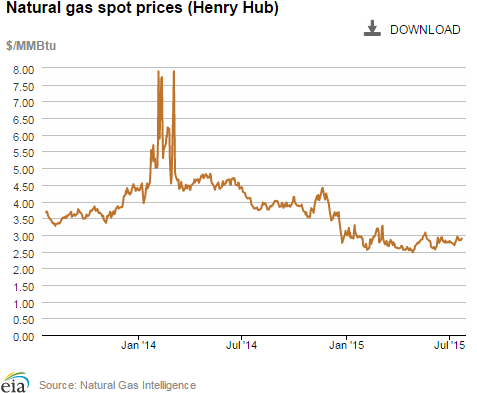
| Spot Prices ($/MMBtu) | Thu, 16-Jul |
Fri, 17-Jul |
Mon, 20-Jul |
Tue, 21-Jul |
Wed, 22-Jul |
|---|---|---|---|---|---|
| Henry Hub |
2.90 |
2.84 |
2.84 |
2.88 |
2.89 |
| New York |
1.45 |
2.50 |
2.98 |
1.99 |
1.58 |
| Chicago |
2.91 |
2.91 |
2.85 |
2.93 |
2.93 |
| Cal. Comp. Avg,* |
3.05 |
2.95 |
2.98 |
3.04 |
3.06 |
| Futures ($/MMBtu) | |||||
| August contract |
2.854 |
2.870 |
2.823 |
2.882 |
2.897 |
| September contract |
2.853 |
2.874 |
2.830 |
2.890 |
2.908 |
| *Avg. of NGI's reported prices for: Malin, PG&E citygate, and Southern California Border Avg. | |||||
| Source: NGI's Daily Gas Price Index | |||||
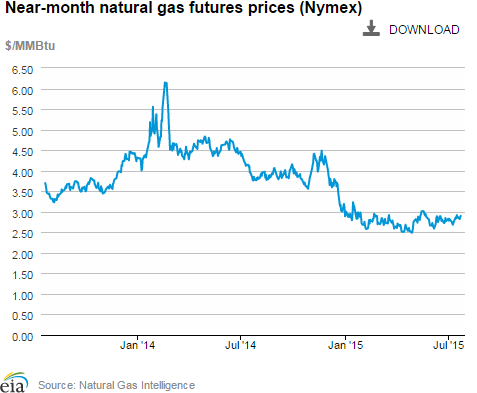
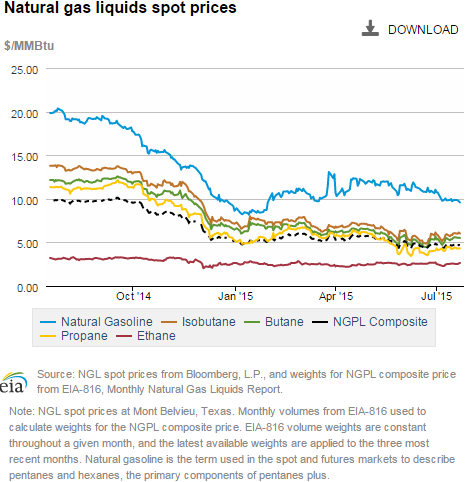
| U.S. natural gas supply - Gas Week: (7/15/15 - 7/22/15) | ||
|---|---|---|
Percent change for week compared with: |
||
last year |
last week |
|
| Gross production | 4.02%
|
-0.95%
|
| Dry production | 3.98%
|
-0.94%
|
| Canadian imports | 25.53%
|
0.00%
|
| West (net) | 25.53%
|
-3.80%
|
| Midwest (net) | 17.93%
|
-0.03%
|
| Northeast (net) | NA |
-85.08%
|
| LNG imports | 66.70%
|
-2.37%
|
| Total supply | 5.39%
|
-0.88%
|
| Source: BENTEK Energy LLC | ||
| U.S. consumption - Gas Week: (7/15/15 - 7/22/15) | ||
|---|---|---|
Percent change for week compared with: |
||
last year |
last week |
|
| U.S. consumption | 14.3%
|
1.5%
|
| Power | 36.9%
|
3.4%
|
| Industrial | -2.9%
|
0.3%
|
| Residential/commercial | -4.7%
|
-1.5%
|
| Total demand | 15.0%
|
1.7%
|
| Source: BENTEK Energy LLC | ||
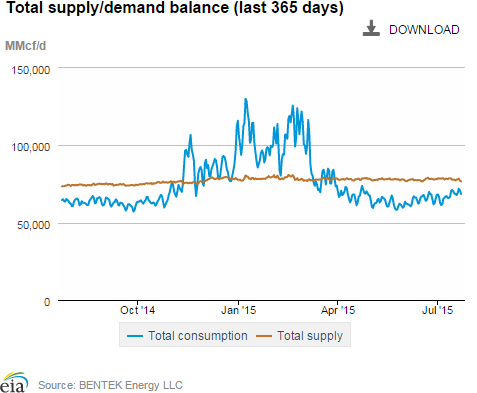
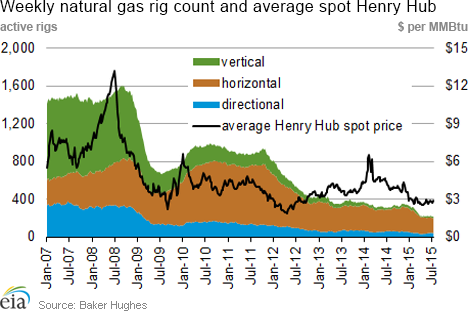
| Rigs | |||
|---|---|---|---|
Fri, July 17, 2015 |
Change from |
||
last week |
last year |
||
| Oil rigs | 638 |
-1.09% |
-58.94% |
| Natural gas rigs | 218 |
0.46% |
-30.79% |
| Miscellaneous | 1 |
0.00% |
-50.00% |
| Rig numbers by type | |||
|---|---|---|---|
Fri, July 17, 2015 |
Change from |
||
last week |
last year |
||
| Vertical | 123 |
1.65% |
-66.39% |
| Horizontal | 650 |
-0.61% |
-49.53% |
| Directional | 84 |
-4.55% |
-61.29% |
| Source: Baker Hughes Inc. | |||
| Working gas in underground storage | ||||
|---|---|---|---|---|
Stocks billion cubic feet (bcf) |
||||
| Region | 2015-07-17 |
2015-07-10 |
change |
|
| East | 1,276 |
1,235 |
41 |
|
| West | 458 |
450 |
8 |
|
| Producing | 1,094 |
1,082 |
12 |
|
| Total | 2,828 |
2,767 |
61 |
|
| Source: U.S. Energy Information Administration | ||||
| Working gas in underground storage | |||||
|---|---|---|---|---|---|
Historical comparisons |
|||||
Year ago (7/17/14) |
5-year average (2010-2014) |
||||
| Region | Stocks (Bcf) |
% change |
Stocks (Bcf) |
% change |
|
| East | 1,092 |
16.8 |
1,339 |
-4.7 |
|
| West | 367 |
24.8 |
434 |
5.5 |
|
| Producing | 747 |
46.5 |
974 |
12.3 |
|
| Total | 2,206 |
28.2 |
2,747 |
2.9 |
|
| Source: U.S. Energy Information Administration | |||||
| Temperature -- heating & cooling degree days (week ending Jul 16) | ||||||||
|---|---|---|---|---|---|---|---|---|
HDD deviation from: |
CDD deviation from: |
|||||||
| Region | HDD Current |
normal |
last year |
CDD Current |
normal |
last year |
||
| New England | 1
|
0
|
0
|
48
|
7
|
-2
|
||
| Middle Atlantic | 1
|
0
|
0
|
55
|
-1
|
-4
|
||
| E N Central | 4
|
3
|
-6
|
42
|
-14
|
5
|
||
| W N Central | 0
|
-3
|
-11
|
82
|
12
|
36
|
||
| South Atlantic | 0
|
0
|
0
|
105
|
8
|
6
|
||
| E S Central | 0
|
0
|
-1
|
109
|
15
|
25
|
||
| W S Central | 0
|
0
|
0
|
130
|
7
|
14
|
||
| Mountain | 0
|
-5
|
0
|
70
|
-8
|
-20
|
||
| Pacific | 0
|
-4
|
0
|
39
|
-3
|
-23
|
||
| United States | 1
|
-1
|
-2
|
74
|
1
|
2
|
||
|
Note: HDD = heating degree-day; CDD = cooling degree-day Source: National Oceanic and Atmospheric Administration | ||||||||
Average temperature (°F)
7-Day Mean ending Jul 16, 2015
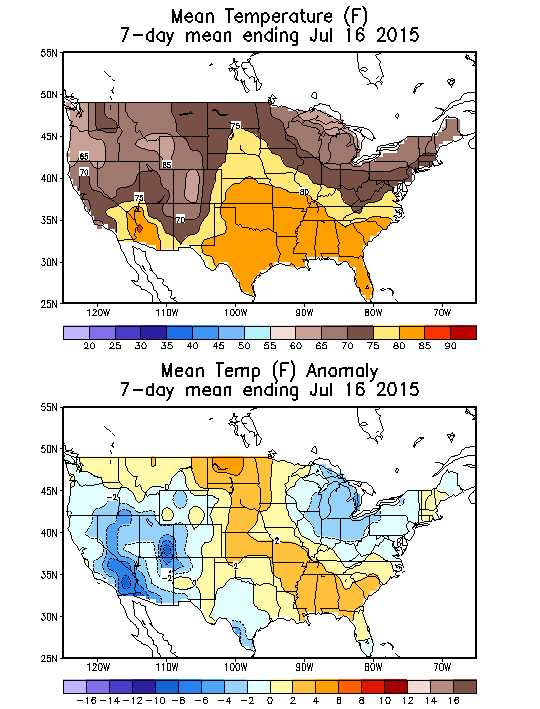
Source: NOAA/National Weather Service
Deviation between average and normal (°F)
7-Day Mean ending Jul 16, 2015

Source: NOAA/National Weather Service

